Related Research Articles
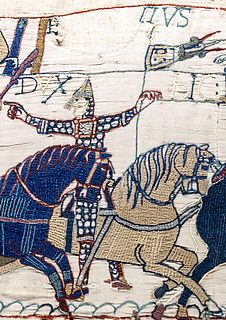
Embroidery is the craft of decorating fabric or other materials using a needle to apply thread or yarn. Embroidery may also incorporate other materials such as pearls, beads, quills, and sequins. In modern days, embroidery is usually seen on caps, hats, coats, overlays, blankets, dress shirts, denim, dresses, stockings, and golf shirts. Embroidery is available with a wide variety of thread or yarn colour.
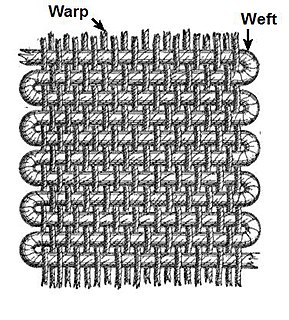
Weaving is a method of textile production in which two distinct sets of yarns or threads are interlaced at right angles to form a fabric or cloth. Other methods are knitting, crocheting, felting, and braiding or plaiting. The longitudinal threads are called the warp and the lateral threads are the weft, woof, or filling. The method in which these threads are inter-woven affects the characteristics of the cloth. Cloth is usually woven on a loom, a device that holds the warp threads in place while filling threads are woven through them. A fabric band that meets this definition of cloth can also be made using other methods, including tablet weaving, back strap loom, or other techniques that can be done without looms.
Ikat is a dyeing technique originated from Indonesia used to pattern textiles that employs resist dyeing on the yarns prior to dyeing and weaving the fabric.

Korean embroidery techniques and artifacts have a long history, but there is the most evidence from the Joseon Dynasty, after the 14th century in Korea. This article talks about the history, styles, preservation, artists, and examples of screens, costumes, and domestic wares of this exacting and beautiful art form.

Artificial plants are imitations of natural plants used for commercial or residential decoration. They are sometimes made for scientific purposes . Artificial plants vary widely from mass-produced varieties that are distinguishable from real plants by casual observation to highly detailed botanical or artistic specimens.

Lenore Tawney was an American artist known for her drawings, personal collages, and sculptural assemblages, who became an influential figure in the development of fiber art.

Silk in the Indian subcontinent is a luxury good. In India, about 97% of the raw mulberry silk is produced in the Indian states of Karnataka, Andhra Pradesh, Tamil Nadu and West Bengal. Mysore and North Bangalore, the upcoming site of a US$20 million "Silk City", contribute to a majority of silk production. Another emerging silk producer is Tamil Nadu where mulberry cultivation is concentrated in Salem, Erode and Dharmapuri districts. Hyderabad, Andhra Pradesh and Gobichettipalayam, Tamil Nadu were the first locations to have automated silk reeling units.
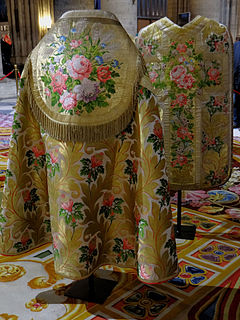
Brocade is a class of richly decorative shuttle-woven fabrics, often made in colored silks and sometimes with gold and silver threads. The name, related to the same root as the word "broccoli", comes from Italian broccato meaning "embossed cloth", originally past participle of the verb broccare "to stud, set with nails", from brocco, "small nail", from Latin broccus, "projecting, pointed".
Assam silk denotes the three major types of indigenous wild silks produced in Assam—golden muga, white pat and warm eri silk. The Assam silk industry, now centered in Sualkuchi, is a labor-intensive industry.
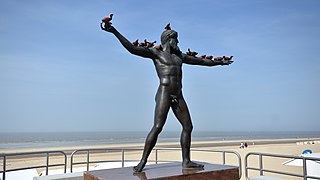
Xu Zhen, born in 1977, is a multimedia artist living and working in Shanghai, China.

Samite was a luxurious and heavy silk fabric worn in the Middle Ages, of a twill-type weave, often including gold or silver thread. The word was derived from Old French samit, from medieval Latin samitum, examitum deriving from the Byzantine Greek ἑξάμιτον hexamiton "six threads", usually interpreted as indicating the use of six yarns in the warp. Samite is still used in ecclesiastical robes, vestments, ornamental fabrics, and interior decoration.
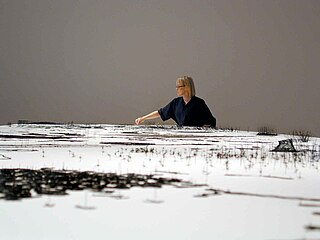
Anne Wilson is a Chicago-based visual artist. Wilson creates sculpture, drawings, Internet projects, photography, performance, and DVD stop motion animations employing table linens, bed sheets, human hair, lace, thread and wire. Her work extends the traditional processes of fiber art to other media. Wilson is a professor in the Department of Fiber and Material Studies at The School of the Art Institute of Chicago.

Nancy Kozikowski is a contemporary American artist specializing in tapestry and painting known for creating large woven art displayed in public places.
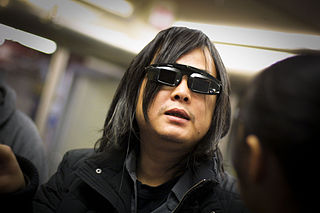
Yang Fudong is a Chinese contemporary artist. In the early 1990s, he began to work with film. He began creating films and videos using 35 mm film. Currently Yang directs films, creates photographs, and creates video installations.

Byzantine silk is silk woven in the Byzantine Empire (Byzantium) from about the fourth century until the Fall of Constantinople in 1453.

Artisans Angkor is a Cambodian social business creating job opportunities for young people in rural areas, while reviving traditional Khmer craftsmanship.
Bruneian art is art from the country of Brunei. Brunei's art includes paintings, jewelry, and clothing.
Jiang Jie, a Chinese artist and lecturer of sculpture studio in Central Academy of Fine Arts. She graduated from Beijing Industrial Art Institute in July 1984, majoring in Non-Traditional Machining; and she started working in the sculpture creation studio in Central Academy of Fine Arts after graduation from CAFA in July 1991, with a Sculpture major.
Virgil Marti is an American visual artist recognized for his installations blending fine art, design, and decor from a range of styles and periods. Marti’s immersive sculptural environments, often evoking nature and the landscape, combine references from high culture with decorative, flamboyant, or psychedelic imagery, materials, and objects of personal significance.

Mary Zicafoose is an internationally-recognized American textile artist, weaver, and teacher who specializes in ikat, an ancient technique in which threads are wrapped, tied and resist-dyed before weaving. Zicafoose is the author of Ikat: The Essential Handbook to Weaving Resist-Dyed Cloth (2020). Her works are part of private and public collections, including at least 16 embassies around the world as part of the U.S. Art in Embassies Program.
References
- 1 2 Prince Claus Fund (2009) biography [ permanent dead link ]
- 1 2 3 Brouwer, Marianne, biography
- 1 2 3 4 Brouwer, Marianne (2009) Article on Liang Shaoji (in Dutch)
- 1 2 Credit Suisse (2010) Today Art Award Archived 2016-03-04 at the Wayback Machine
- 1 2 ShanghART Gallery, resume
- ↑ Metropolis M (December 14, 2009) Prins Claus Fonds toont werk van laureaat Liang Shaoji (in Dutch)
- ↑ ShanghART Gallery, Natural Series No.25
- ↑ Brouwer, Marrianne (August 20, 2007) Cloud
- ↑ ShangART Gallery, Cloud (no. 101)